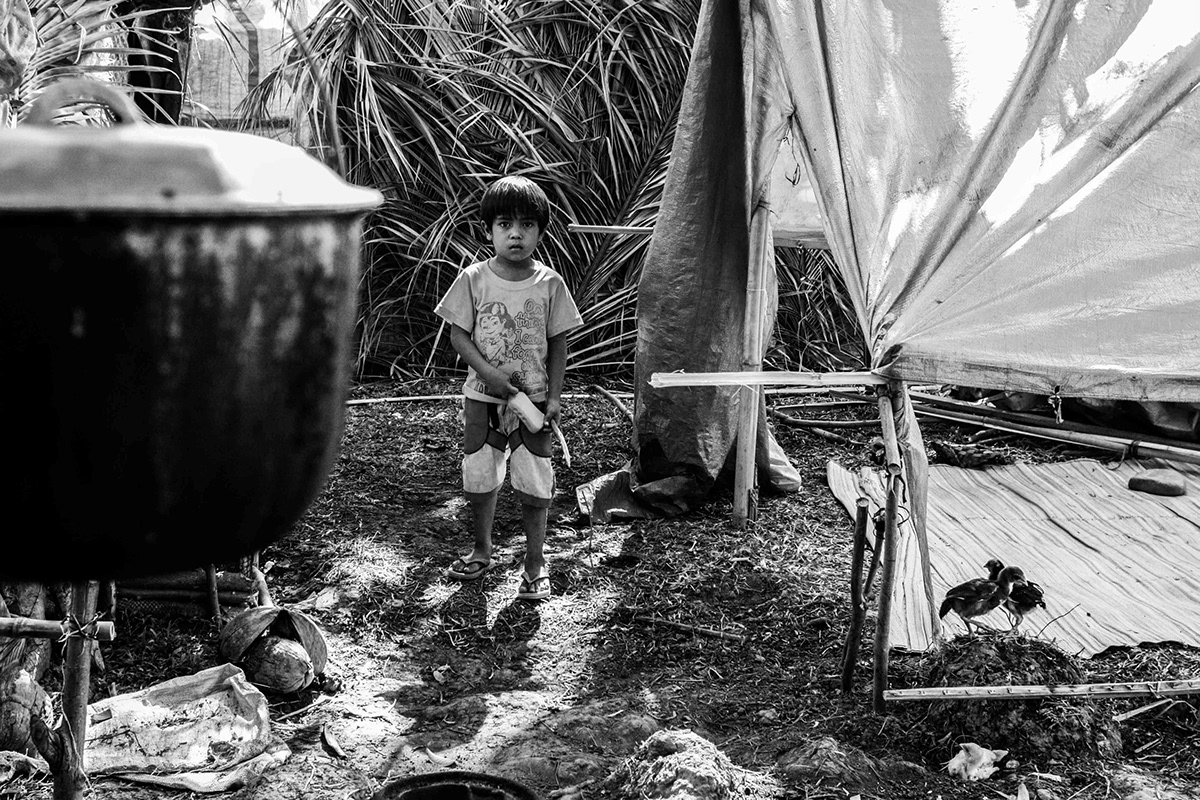The Bakwits of Shariff Aguak
Teach Peace Build Peace Movement
Words by: Paul Dawnson Formaran / Photo by: Dante Dennis Diosina Jr
Words by: Paul Dawnson Formaran / Photo by: Dante Dennis Diosina Jr

There were more than 2,000 families displaced now living in temporary shelters in Shariff Aguak, Maguindanao. As of March 28, 2015, there have been a total of 91,602 evacuees in Maguindanao. | Photo by Dante Dennis Diosina Jr. for Teach Peace Build Peace Movement.
“Mag-bakwit” or “to evacuate” is what the children, men and women of Lapok and Tapikan villages did when they heard gunshots in the middle of the night.
Most of them ran on foot, with their carabaos, chickens, ducks, and anything they could carry with them, covering at least two kilometers of distance away from their homes.

A bakwit woman is tending to her cows. Many of the bakwits herded their livestock for at least two kilometers from her home villages, fleeing from the gunfight. | Photo by Dante Dennis Diosina Jr. for Teach Peace Build Peace Movement
That is what happened to a community living in tents in Shariff Aguak town since February 2015. But without supplies like trapal (tarpaulin) and banig (hand-woven mats), the ground is barely covered, and the tents have holes.
One of the women living in a temporary shelter recalls a night when it rained and water seeped everywhere. Worms crawled out of the ground and ants fell from the trees, she says. But without the rain, the heat coarsened and cracked the earth making even just walking around painful.

With tarpaulin in scarce supply, the bakwits make their shelters from various kinds of cloths they were able to bring from their homes and from what are available in the area, like dry coconut leaves and dead wood. They cover the ground with banig, hand-woven mats that the bakwits learned to make at a young age. | Photo by Dante Dennis Diosina Jr. for Teach Peace Build Peace Movement
The weather and their temporary shelters, however, are the least of their worries. Supply of toiletries and food has not been enough for their families. They have always been wondering how to survive whenever they need to evacuate. “Kung ‘di kami ma-suplayan dito, eh ‘di wala, (Here, if we are not given supplies, we have nothing,)” Noraisa from Tapikan says.

A bakwit woman is removing kernels from a corncob. Many bakwits are worried that they cannot restart farming, their primary livelihood, in the middle of dry season. | Photo by Dante Dennis Diosina Jr. for Teach Peace Build Peace Movement
But they won’t go home even if they long to. Aside from having no livelihoods to go back to with their farming cycles disrupted, they are afraid of getting hit by stray bullets or their homes hit with mortars.
They need assistance, but their sincere hope is for things to go back to normal. They do not want to live longer in a situation where they are in constant fear of getting caught in the crossfire.

A bakwit man is praying in a makeshift prayer area. Despite disruption in all aspects of their lives, prayer is constant. | Photo by Dante Dennis Diosina Jr. for Teach Peace Build Peace Movement.
The older ones say there was peace for a time. The last time they experienced beingbakwits was when the peace negotiations collapsed in 2008 and warlords ruled the area, grabbing land from the indigenous.

Tatay Tok, who has one of the biggest families in the community of temporary shelters, is recounting the past times he had to evacuate. For many of the older folks, it has been a struggle just trying to live a quiet life, farming their land. | Photo by Dante Dennis Diosina Jr. for Teach Peace Build Peace Movement
For most of the children, this is their first time to be bakwits. Their education is disrupted. Their simple dreams of helping their families are now farther out of their reach.

Photo by Dante Dennis Diosina Jr. for Teach Peace Build Peace Movement

Photo by Dante Dennis Diosina Jr. for Teach Peace Build Peace Movement.

There are many children of different ages in the bakwit community. Those who are old enough to understand really worry about their education. They are afraid of not being able to help out their families in the best way possible. | Photo by Dante Dennis Diosina Jr. for Teach Peace Build Peace Movement.
“Napakahirap talaga ng ganito, (It’s really difficult here,)” Samraida says. At 20 years old, Samraida is four months pregnant with her first child.

Samraida, Tok’s daughter-in-law, is looking after Tok’s youngest child, a one-year old boy. At 20 years old, she is four months pregnant with Tok’s grandchild. | Photo by Dante Dennis Diosina Jr. for Teach Peace Build Peace Movement

Samraida is preparing a duyan, a makeshift cradle. | Photo by Dante Dennis Diosina Jr. for Teach Peace Build Peace Movement.
“Di natin alam kung anong kinabukasan ng mga anak natin kung patuloy lang ‘yung ganito, ‘yung giyera. (We don’t know what our children’s future will be if this continues, this battle.)”
Another generation is inheriting the conflict unless something is done.
(COPYRIGHT/2015)
